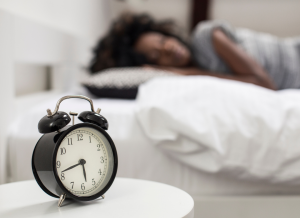These days, most smart-watches and activity trackers have features for sleep tracking.
Sleep gives the body a chance to rest and recover from the day. But a lot is happening behind the scenes while you collect your ZZZ’s! Sleep is hugely important for both physical and mental restoration. A lack of quality sleep can have consequences for emotional regulation, immunity, and of course those well-known feelings of slowed physical and cognitive performance.
Tracking your sleep can be useful to provide insight into changes in mood or energy levels throughout the week, and we frequently use this data with our clients. But while understanding sleep quantity is straightforward, monitoring sleep quality does require some understanding of the different phases of sleep and the way that we cycle between each throughout the night.
Have you personally noticed the different types of sleep data on your device and wondered what they mean? Consider this your introductory guide to sleep tracking!
REM versus Non-REM, Light versus Deep
REM stands for ‘rapid eye movement’ and throughout the night, we cycle in and out of REM sleep numerous times. When our head first hits the pillow, we start with non-REM sleep (i.e. no rapid eye movements), where we stay for roughly 60-90 minutes.
Non-REM sleep comes in 3 stages:
- Stage 1 is light sleep, lasting for 5-10 minutes. This is the stage where you are juuust dozing off but can still be easily woken. You may not even have realised that you’ve been asleep!
- Stage 2 is where your heart rate and breathing starts to slow, your muscles relax, body temperature drops, and brain waves slow. This is the middle ground between stage 1 and stage 3 – we spend the majority of our sleeping hours here.
- Stage 3 is deep sleep. In this stage, your brain waves form very slow ‘delta’ waves, and your heart rate and breathing rate is at its slowest. This is the sleep that you need in order to wake up feeling refreshed the next day, as this is when the body undergoes those crucial processes for physical repair and recovery. Stage 3 is longest during the initial hours of the night and decreases in duration throughout the night.

Only after we have been through all 3 phases do we progress to REM sleep. This is when we dream the most vividly! As the name suggests, this phase involves rapid eye movements from side to side (under your eyelids). This part of sleep is important for learning, memory consolidation, emotional regulation and information processing. While deep sleep is important for physical restoration, REM sleep is important for cognitive restoration.
During this phase, breathing, heart rate and blood pressure increases, and your limbs are temporarily immobilised to prevent you from acting out your dreams. Brain activity increases to levels similar to being awake! Who would have thought this all happens without you even knowing about it?
You then cycle back to non-REM and move through the phases once again. A full cycle lasts for 90-110 minutes, with the REM sleep getting longer over the night and deep sleep getting shorter. Most people will go through 3-5 REM cycles a night.
Soooooo. . . What do I do with the data?
Now that you know what it all means, you might be wondering – what am I actually aiming for with all of this data? If you are someone who struggles with maintaining a healthy sleeping pattern, or you wake up feeling unrefreshed, sleep data gives you a great tool to monitor the effectiveness of sleep hygiene practises.
For example, if someone wanted to improve their sleep, they might decide to implement a meditation practice in the evening. But how do you know if it’s working?
Here are just a few of the things we look at as Exercise Physiologists:
- Total sleep per night – aim for 7-9 hours per night
- Percentage of REM sleep – aim for 20-25%
- Percentage of deep sleep – aim for 10-25%
- Improvements in continuity of sleep, or reductions in wake time
Every watch is different, so just choosing 1 or 2 helpful stats can simplify things. Some watches will even collate these details for you along with your activity data and provide you with a daily recovery score!
Trust us when we say that as far as pursuits go, taking steps toward good sleep is a worthwhile one… And seeing as we live in the technology age, we might as well use it to our advantage!
Author: Yolanda van Vugt (edited by Tessa Nielsen) Clinical Exercise Physiologist and Content Creator at Specialised Health
References:
- https://my.clevelandclinic.org/health/articles/12148-sleep-basics
- https://www.ninds.nih.gov/Disorders/Patient-Caregiver-Education/Understanding-Sleep
- https://www.whoop.com/thelocker/what-is-rem-sleep/
- https://blog.fitbit.com/sleep-stages-explained/
Let’s connect, find us:
Have you got a claimant that would benefit from E.P. support? Refer to the team!
#exercisephysiology #exerciserehab #rehabilitation #lifeinsurance #incomeprotection #ctp #workcover #mobile #mobileexercisephysiology #sleep #sleeptracking #fatigue #mentalhealth #cancer #musculoskeletal #injury #pain #physio #physiotherapy #Sydney #Brisbane #Melbourne #Adelaide #Auckland #Waikato #BayofPlenty #Wellington #Otago #Christchurch